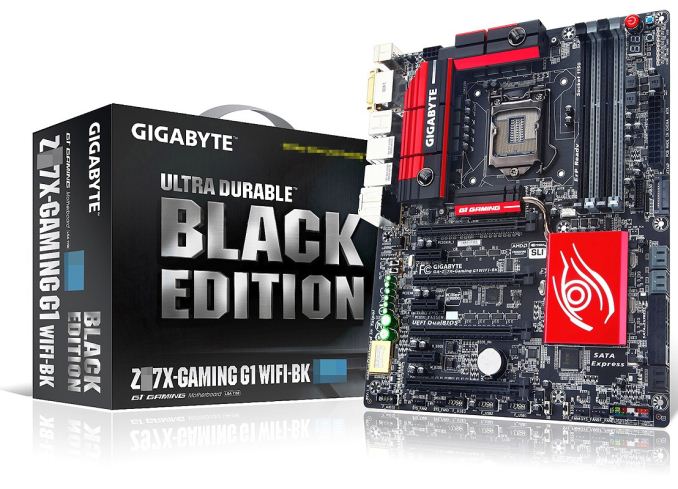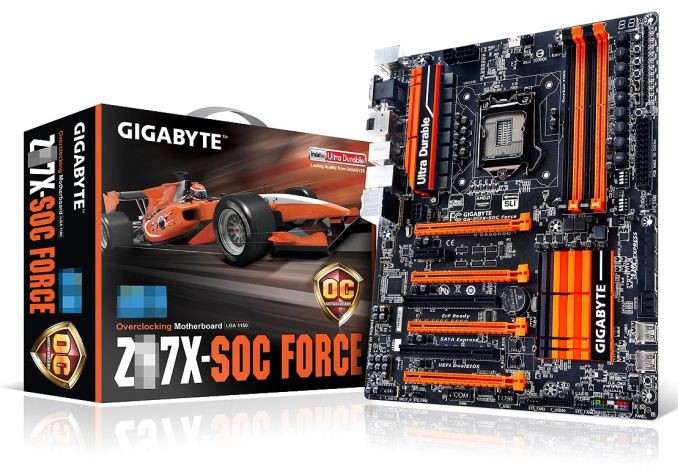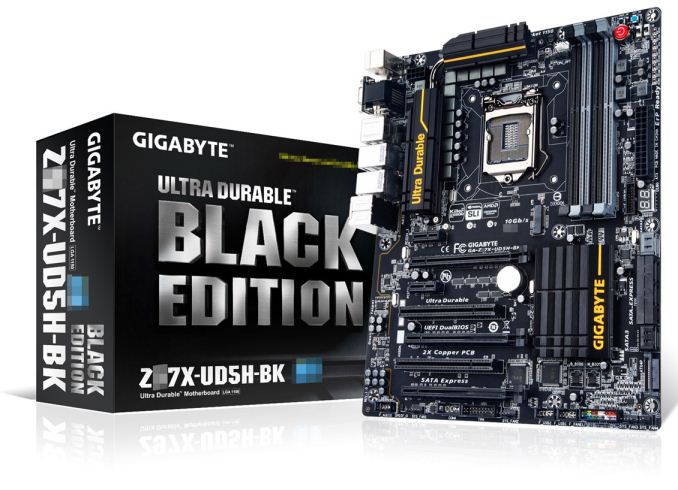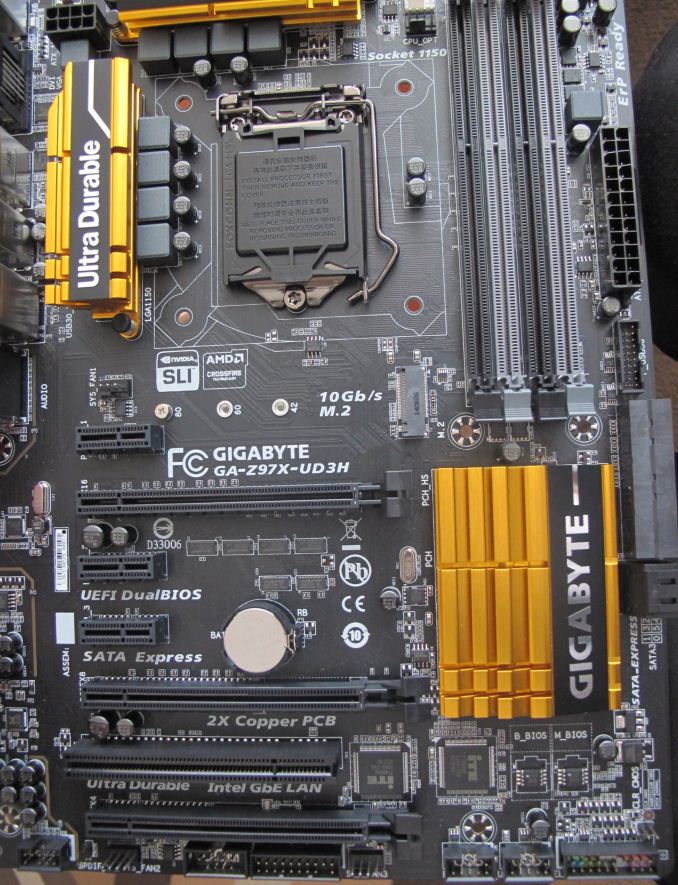Upcoming Intel Based Motherboards from GIGABYTE, ASUS, MSI and ASRock
by Ian Cutress on April 28, 2014 3:30 AM ESTGIGABYTE’s New Products
Pictures launched of GIGABYTE’s Facebook pages this week point to at least four new models covering gaming, overclocking and connectivity. Part of GIGABYTE’s new range is its Black Editions (BK), reducing the color of the heatsinks and components to as black as possible. It is unclear if some models will solely be in BK mode or both will be offered.
First up is the next Gaming motherboard, called the G1 WIFI-BK:
At first glance users should notice the integrated air and water cooling power delivery heatsink, designed for system builders to use their own fittings. The extended heatsink seems to be masking a PLX8747 chip, which would explain the four PCIe slots and suggest x8/x8/x8/x8 operation for GPUs. Voltage check points are in the top right, along with a SATA power connector for PCIe power. The SATA ports are split with SATA Express ports, and the audio subsystem uses GIGABYTE’s OP-AMP, AMP-UP and gain switches, paired with a Creative audio codec.
For overclocking, the SOC Force:
No PLX chip this time, giving the four PCIe layout an x8/x4/x4 + x4 similar to the GIGABYTE Z87X-OC motherboard we reviewed last year. The overclocking buttons and switches at the top right are back, along with the USB ports next to the SATA ports. For PCIe power there is a 6-pin PCIe connector above the PCIe slots. For Z87 this level of motherboard was in the $200 range, forgoing some of the exotic features (particularly on audio) to provide a less expensive overclocking oriented platform.
For connectivity, the UD7 TH:
We did not get a chance to review the Z87 version of the UD7, but judging by the markings on the PCB here it is safe to say that it is being updated for Thunderbolt 2. While we cannot see the rear IO panel, it should be safe to assume that the TB2 ports are on the rear IO rather than an add-in card due to the lack of a TB header. The UD7 TH seems a bit toned down this time, with fewer SATA ports (making room for the SATA Express) and no obvious IR355x ICs. This might potentially leave room for a UD9 in the product stack for the future.
For the mainstream, the UD5H-BK:
The Black Edition version for the UD5H lives up to its name, with a few streaks of yellow on the heatsinks showing. Rather than equipping TB2 like the UD7 TH, the UD5H-BK uses more substantial power delivery and offers a similar SATA port/PCIe arrangement. In fact these two motherboards look rather alike, but with money being spent in different places. I would not be surprised if they end up in the same price bracket.
Additional: We have just been given the go-ahead to post these un-doctored images from a GIGABYTE media event, showing most of the motherboards off in more detail including the name of the chipset.
The newer one from this list is the UD3H:
This looks a lot like the UD5H and UD7 in terms of color scheme, and offers M.2 with an Intel NIC. This board seems to be equipped with SATA Express (as some of the images show, four SATA ports with two being modified for SATA Express) and one USB 3.0 header. This motherboard looks a lot less busy around the socket area as well, in terms of extra resistors.



























58 Comments
View All Comments
Marlowe - Monday, April 28, 2014 - link
Yeah this transfer to PCIe based storage is really exciting. But why don't we see any drives in the shops? The PCIe M.2 SSD's are impossible to find, just the "fake" SATA based ones that offer no performance advantage over mSATA are available. Also where are the 1 GB/s+ fast 2,5" SATA-express drives?Do you think the x2 M.2 will just be a stopgap solution until we get x4 across the board? ASRock seems to already be on the way. And how fast do you think we'll see x8 and x16 based M.2?
SirKnobsworth - Monday, April 28, 2014 - link
The M.2 spec only supports x4 at the moment. I don't know if there are enough pins to support more lanes in a future revision. We are starting to see x8 PCIe SSDs though, not that consumer level PCs will have enough lanes to support those for another year or so.Marlowe - Tuesday, April 29, 2014 - link
Thanks for the answer.Antronman - Monday, April 28, 2014 - link
Because PCIe storage is (currently) very expensive.It's the fastest available, but comes at a steep price.
James5mith - Monday, April 28, 2014 - link
I would love to see more coverage of the "industrial" side boards from Asrock. I only recently discovered them, and just like on the consumer side, they give their competitors (for me, Supermicro) a serious run for the money on both cost and feature set.xeizo - Monday, April 28, 2014 - link
Wake me up when Haswell-E is available ...dj_aris - Monday, April 28, 2014 - link
Storage in 2014 is a mess. We know SATA and mSATA are limited to 6GBps but M.2 and SATA Express come in several flavors (speeds) but without any actual availability (excluding from the SATA M.2 drives which are actually mSATA drives with M.2 adaptors). So, since 9-series boards are actually all about supporting new storage options (Broadwell support is another reason I guess but there is no Broadwell yet), it's way too early to pick a board because you don't actually know which format will take off. So frustrating.willis936 - Monday, April 28, 2014 - link
Perhaps that's went they're all strutting their usual marketing fluff before even announcing a chipset.Edkiefer - Monday, April 28, 2014 - link
On first 2 Gigabyte MB with 4 PCIe slots , why do they have the 16x slot at very top slot . this way your limited on big air coolers like D14/15, NH 14S .unless second pcie can support 16x with single card .sherlockwing - Monday, April 28, 2014 - link
Because people with that much money to buy a 4PCIe board are going water most of the time anyway. This have been the trend on all flagship boards(ASUS ROGs the last few generations for example).